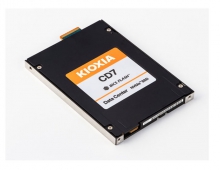
HP Touts Tiny Wireless Chip
Researchers at Hewlett-Packard Co. have developed a tiny wireless data chip that can store up to 100 pages of text and could ultimately be used in a variety of consumer and commercial applications, HP said late on Sunday.
Developed over four years by HP Labs' campus in Bristol, England, the chip is about the size of the head of a match and could potentially store a patient's medical chart on a hospital band, said Howard Taub, associate director at HP Labs.
"There's no question that it has long-term potential," said Tim Bajarin, president of market research firm Creative Strategies of Campbell, California. "But keep in mind this is a technology announcement. It's difficult to predict what applications will be developed and what we would call the 'killer application' for this."
Consumers could store audio commentary, music or short videos on such a chip, affixed to a printed digital photograph. Devices to read and write data on the chip would then eventually be embedded in cell phones, handheld computers, personal computers, printers, or small standalone readers.
"This really bridges the digital and physical worlds," Taub said. "The digital data is attached to the physical object it's related to."
Palo Alto, California-based HP plans to take the technology to industry standards bodies in hopes of it being welcomed across the technology sector, Taub said. While broad commercial applications are at least two years away, HP will license the technology to partners, customers and rivals well before that.
"Licensing will almost definitely be part of it," Taub said of HP's plans to cash in on its investment in the technology, which was developed by the "Memory Spot" team within HP Labs.
While similar in some ways to RFID -- radio frequency identification -- chips, there are key differences in Memory Spot technology in data transfer rates, storage and security.
The chip can transfer data at 10 megabits per second, 10 times faster than Bluetooth wireless technology, comparable to Wi-Fi rates and far faster than RFID. Also, HP has managed to store up to 4 megabits in working prototypes of the chip, far more than an RFID chip can store.
HP said the chips could be embedded in paper or stuck to surfaces, and may be sold eventually as self-adhesive dots.
"At a buck a piece, that could be a really good business," Taub said, noting that at production volumes of millions of chips, a dollar per chip would be a reasonable cost.
The chip is comprised of a capacitor array, modem, loop antenna, a targeted microprocessor, memory driver and memory, all fabricated as one piece, which helps cut production costs.
It needs no battery or external electronics, getting its power via inductive coupling from the read-write device, Taub said. Inductive coupling is an energy transfer from one circuit component to another through a shared electromagnetic field.
The reader must be touched to the chip or placed within a millimeter for data transfer to occur, which could render it safer than typical RFID chips, whose range of up to about 10 feet exposes them more to data thieves, Taub said.
"There's no question that it has long-term potential," said Tim Bajarin, president of market research firm Creative Strategies of Campbell, California. "But keep in mind this is a technology announcement. It's difficult to predict what applications will be developed and what we would call the 'killer application' for this."
Consumers could store audio commentary, music or short videos on such a chip, affixed to a printed digital photograph. Devices to read and write data on the chip would then eventually be embedded in cell phones, handheld computers, personal computers, printers, or small standalone readers.
"This really bridges the digital and physical worlds," Taub said. "The digital data is attached to the physical object it's related to."
Palo Alto, California-based HP plans to take the technology to industry standards bodies in hopes of it being welcomed across the technology sector, Taub said. While broad commercial applications are at least two years away, HP will license the technology to partners, customers and rivals well before that.
"Licensing will almost definitely be part of it," Taub said of HP's plans to cash in on its investment in the technology, which was developed by the "Memory Spot" team within HP Labs.
While similar in some ways to RFID -- radio frequency identification -- chips, there are key differences in Memory Spot technology in data transfer rates, storage and security.
The chip can transfer data at 10 megabits per second, 10 times faster than Bluetooth wireless technology, comparable to Wi-Fi rates and far faster than RFID. Also, HP has managed to store up to 4 megabits in working prototypes of the chip, far more than an RFID chip can store.
HP said the chips could be embedded in paper or stuck to surfaces, and may be sold eventually as self-adhesive dots.
"At a buck a piece, that could be a really good business," Taub said, noting that at production volumes of millions of chips, a dollar per chip would be a reasonable cost.
The chip is comprised of a capacitor array, modem, loop antenna, a targeted microprocessor, memory driver and memory, all fabricated as one piece, which helps cut production costs.
It needs no battery or external electronics, getting its power via inductive coupling from the read-write device, Taub said. Inductive coupling is an energy transfer from one circuit component to another through a shared electromagnetic field.
The reader must be touched to the chip or placed within a millimeter for data transfer to occur, which could render it safer than typical RFID chips, whose range of up to about 10 feet exposes them more to data thieves, Taub said.





















